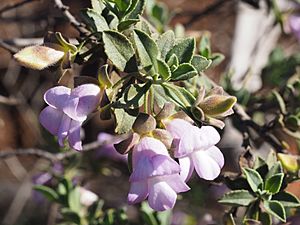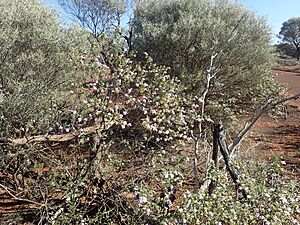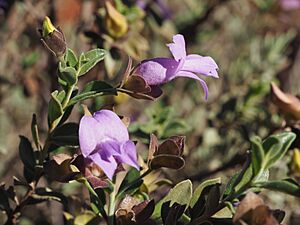Eremophila georgei facts for kids
Quick facts for kids Eremophila georgei |
|
|---|---|
 |
|
| Eremophila georgei leaves and flowers | |
| Scientific classification | |
| Genus: |
Eremophila (plant)
|
| Species: |
georgei
|
Eremophila georgei is a beautiful flowering plant that belongs to the figwort family. This plant is special because it is only found in Western Australia. It's a common shrub that grows in many places across the central parts of the state. You can often spot it on rocky hills and ridges. This plant has interesting leaves with jagged edges and pretty flowers that can be mauve, purple, or pink.
Contents
What it Looks Like
Eremophila georgei is a shrub that can grow from about 1 foot (0.3 meters) to 10 feet (3 meters) tall. Its branches are covered in soft, white hairs. The leaves grow one after another along the stem. They are shaped like an oval or an egg and have edges that look like saw teeth. Most leaves are about 0.3 to 0.9 inches (8 to 23 mm) long and 0.2 to 0.4 inches (5.5 to 10 mm) wide. Both sides of the leaves are also covered in white hairs and have small, raised bumps called glands.
The flowers grow one by one where the leaves meet the stem. Each flower sits on a hairy stalk that is usually 0.6 to 1.4 inches (16 to 36 mm) long. There are 5 sepals, which are like small leaves that protect the flower bud. These sepals are hairy, sticky, and often shiny. They can be greenish-brown or purple and are about 0.3 to 0.6 inches (8 to 15 mm) long.
The petals of the flower are joined together at the bottom to form a tube. This tube is 0.6 to 1.4 inches (16 to 35 mm) long. The outside of the flower tube is mauve, purple, or pink, while the inside is white. The outside is covered in hairs. The tips of the petals on the inside are smooth, but the inside of the tube is full of soft, woolly hairs. The 4 stamens (the parts that make pollen) are completely hidden inside the flower tube.
Eremophila georgei flowers for a long time, from March all the way to December. After the flowers, the plant grows fruits. These fruits are hairy, about 0.2 to 0.3 inches (5.5 to 8.5 mm) long, and have a pale yellow-brown papery covering.

How it Got its Name
The plant Eremophila georgei was first officially described by a scientist named Ludwig Diels in 1905. He published his description in a science journal. The second part of its name, georgei, was chosen to honor William George. He was a mine manager who found the first example of this plant in 1902. He found it in the goldfields near Mount Margaret.
Where it Grows
This type of eremophila plant is very common in the central parts of Western Australia. It likes to grow in sandy, clay, and stony soils. You can find it on flat areas and rocky ridges. It grows across many different natural areas, including the Avon Wheatbelt, Central Ranges, Coolgardie, Gascoyne, Gibson Desert, Great Victoria Desert, Murchison, Nullarbor, and Yalgoo regions.
Conservation Status
The Western Australian Government's Department of Parks and Wildlife has looked at Eremophila georgei. They have decided that it is "not threatened," which means it is not in danger of disappearing.
Growing Eremophila georgei
This eremophila is a very attractive plant. People like it because of its large, colorful flowers that often bloom for a long time. You can grow this plant in a few ways. One way is by taking cuttings, which are small pieces of the plant that can grow roots. Another way is by grafting it onto another plant called Myoporum. Grafting means joining a piece of Eremophila georgei onto the root system of a Myoporum plant. This method is better if you want to grow the plant in heavy soils or in places with lots of humidity.
It can take several months for cuttings to grow roots, even in warm weather. Once planted, Eremophila georgei can grow well in full sun or in light shade. It doesn't need much water and can handle frost once it is fully grown.


